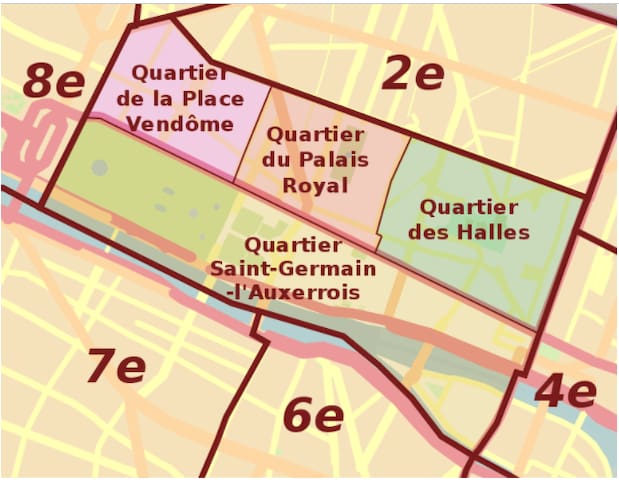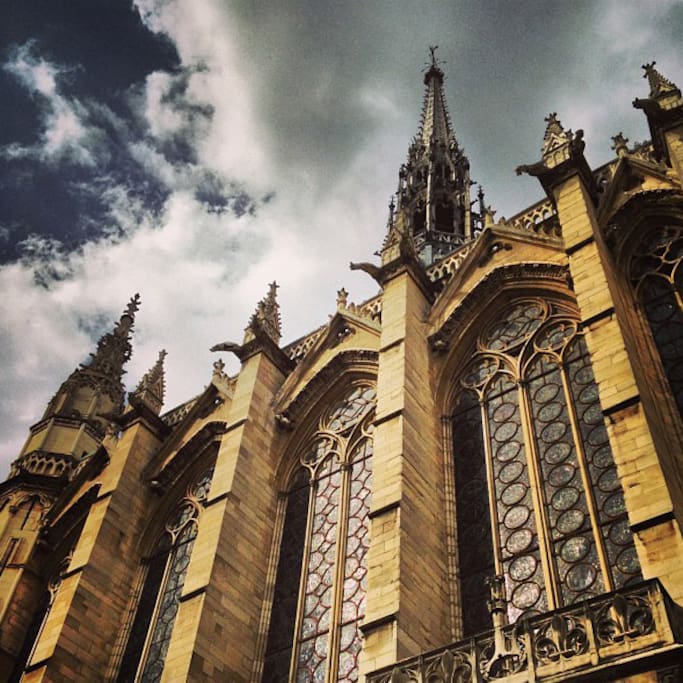Gastronomie
Tenzo by Hissa, 123 Rue St Honoré, 75001 Paris
Refined Japanese food served in the sober setting of a restaurant and tea room. Bento delivery.
6 personas locales recomiendan
TENZO by Hissa
117 Rue St HonoréTenzo by Hissa, 123 Rue St Honoré, 75001 Paris
Refined Japanese food served in the sober setting of a restaurant and tea room. Bento delivery.
La Poule au Pot, 9 Rue Vauvilliers, 75001 Paris
In a 1930's style decor, this brasserie serves great French classics such as the poule au pot.
49 personas locales recomiendan
La Poule au Pot
9 Rue VauvilliersLa Poule au Pot, 9 Rue Vauvilliers, 75001 Paris
In a 1930's style decor, this brasserie serves great French classics such as the poule au pot.
Pirouette, 5 Rue Mondétour, 75001 Paris
Pleasant setting, warm welcome and smiling staff. A varied menu, 4 starters; 4 main courses; 4 desserts. Home-made cuisine. Served just right with the end result being an excellent meal.
Well-stocked wine list.
51 personas locales recomiendan
Pirouette
5 Rue MondétourPirouette, 5 Rue Mondétour, 75001 Paris
Pleasant setting, warm welcome and smiling staff. A varied menu, 4 starters; 4 main courses; 4 desserts. Home-made cuisine. Served just right with the end result being an excellent meal.
Well-stocked wine list.
Neighbourhood Guide
The first arrondissement of Paris is one of the most central districts of the capital. It is home to the Halles district, one of the oldest districts in the city, dating back to the early Middle Ages.
Paris 1er is divided into four administrative districts: Quartier Saint-Germain l'Auxerrois, Quartier des Halles, Quartier du Palais-Royal and Quartier de la Place Vendôme.
Famous streets, squares and quays are also to be found here, including: Place du Chatelêt, Quai du Louvre, Quai des Orfèvres, Rue de Rivoli, Rue Saint-Honoré, Quai des Tuileries, Place Vendôme and Rue Montmartre.
The public institutions located in the first arrondissement of Paris are the Bank of France, the Ministry of Justice, the Court of Auditors, the Constitutional Council, the Palais de Justice, the Hotel des Postes, the Council of State and the Bourse de Commerce et de l'Industrie.
Numerous prestigious monuments adorn the streets and squares of Paris 01: the Arc de Triomphe du Carrousel, the Palais du Louvre, the Forum des Halles, the Palais-Royal, the Colonne Vendôme, the Samaritaine, the Paris Stock Exchange.
Important green spaces provide places to walk and relax in the centre of Paris and invite you to discover the landscape heritage of the most visited capital in the world, notably: the Jardin des Halles, the Jardin du Carrousel, the Jardin des Tuileries, the Square du Vert-Galant, the Jardin du Palais-Royal.
How can you visit the 1st arrondissement and not take advantage of its cultural infrastructures: the Louvre Museum, the Chatelêt Theatre, the Comédie-Française, the Musée des Arts Décoratifs, the Galerie nationale du Jeu de Paume, the Musée de l'Orangerie.
Finally, the religious buildings have nothing to envy to the other monuments, see for yourself by discovering: the Church of Notre-Dame de l'Assomption, the Sainte-Chapelle, the Protestant Temple of the Louvre Oratory, the Church of Saint-Eustache, the Church of Saint-Roch and the Church of Saint-Germain-l'Auxerrois.
As you will have understood, visiting the 1st arrondissement of Paris is not something you can do in a day! To enjoy and discover all its treasures that the whole world photographs, you have to take the time to stay, get organised and don't hesitate to walk! And it's worth it, if Paris 01 is perhaps THE most visited district in the world...it's not by chance.
28 personas locales recomiendan
1st arrondissement of Paris
The first arrondissement of Paris is one of the most central districts of the capital. It is home to the Halles district, one of the oldest districts in the city, dating back to the early Middle Ages.
Paris 1er is divided into four administrative districts: Quartier Saint-Germain l'Auxerrois, Quartier des Halles, Quartier du Palais-Royal and Quartier de la Place Vendôme.
Famous streets, squares and quays are also to be found here, including: Place du Chatelêt, Quai du Louvre, Quai des Orfèvres, Rue de Rivoli, Rue Saint-Honoré, Quai des Tuileries, Place Vendôme and Rue Montmartre.
The public institutions located in the first arrondissement of Paris are the Bank of France, the Ministry of Justice, the Court of Auditors, the Constitutional Council, the Palais de Justice, the Hotel des Postes, the Council of State and the Bourse de Commerce et de l'Industrie.
Numerous prestigious monuments adorn the streets and squares of Paris 01: the Arc de Triomphe du Carrousel, the Palais du Louvre, the Forum des Halles, the Palais-Royal, the Colonne Vendôme, the Samaritaine, the Paris Stock Exchange.
Important green spaces provide places to walk and relax in the centre of Paris and invite you to discover the landscape heritage of the most visited capital in the world, notably: the Jardin des Halles, the Jardin du Carrousel, the Jardin des Tuileries, the Square du Vert-Galant, the Jardin du Palais-Royal.
How can you visit the 1st arrondissement and not take advantage of its cultural infrastructures: the Louvre Museum, the Chatelêt Theatre, the Comédie-Française, the Musée des Arts Décoratifs, the Galerie nationale du Jeu de Paume, the Musée de l'Orangerie.
Finally, the religious buildings have nothing to envy to the other monuments, see for yourself by discovering: the Church of Notre-Dame de l'Assomption, the Sainte-Chapelle, the Protestant Temple of the Louvre Oratory, the Church of Saint-Eustache, the Church of Saint-Roch and the Church of Saint-Germain-l'Auxerrois.
As you will have understood, visiting the 1st arrondissement of Paris is not something you can do in a day! To enjoy and discover all its treasures that the whole world photographs, you have to take the time to stay, get organised and don't hesitate to walk! And it's worth it, if Paris 01 is perhaps THE most visited district in the world...it's not by chance.
Iconic Places
The Conciergerie is a former courthouse and prison in Paris, France, located on the west side of the Ile de la Cité, it was originally part of the former royal palace, the Palais de la Cité, which also included the Sainte-Chapelle. Two large medieval halls remain from the royal palace.
100 personas locales recomiendan
Conciergerie
2 Bd du PalaisThe Conciergerie is a former courthouse and prison in Paris, France, located on the west side of the Ile de la Cité, it was originally part of the former royal palace, the Palais de la Cité, which also included the Sainte-Chapelle. Two large medieval halls remain from the royal palace.
Palace and gardens with 17th century galleries housing shops & Daniel Buren's striped columns in the courtyard.
96 personas locales recomiendan
Domaine National du Palais-Royal
8 Rue de MontpensierPalace and gardens with 17th century galleries housing shops & Daniel Buren's striped columns in the courtyard.
The Musée National de l'Orangerie is a museum of Impressionist and Post-Impressionist paintings located in the Tuileries Gardens, at the western end of the Terrasse du bord de l'eau, Place de la Concorde, in Paris, attached since 2010 to the Musée d'Orsay.
287 personas locales recomiendan
Museo de la Orangerie
The Musée National de l'Orangerie is a museum of Impressionist and Post-Impressionist paintings located in the Tuileries Gardens, at the western end of the Terrasse du bord de l'eau, Place de la Concorde, in Paris, attached since 2010 to the Musée d'Orsay.
The Sainte-Chapelle, also known as the Sainte-Chapelle du Palais, is a palatial chapel built on the Ile de la Cité in Paris at the request of Saint Louis to house the Holy Crown of Thorns, a piece of the True Cross, as well as various other relics of the Passion that he had acquired from 1239.
331 personas locales recomiendan
Sainte-Chapelle
10 Bd du PalaisThe Sainte-Chapelle, also known as the Sainte-Chapelle du Palais, is a palatial chapel built on the Ile de la Cité in Paris at the request of Saint Louis to house the Holy Crown of Thorns, a piece of the True Cross, as well as various other relics of the Passion that he had acquired from 1239.
At the end of the 12th century, Philip Augustus built a fortress on the banks of the Seine to defend Paris. Two centuries later, Charles V transformed the building into a royal residence. Art historian Amel Ferhat tells Jacques Beauchamp about the evolution of the Louvre, which became a museum in 1793.
4022 personas locales recomiendan
Museo del Louvre
Rue de RivoliAt the end of the 12th century, Philip Augustus built a fortress on the banks of the Seine to defend Paris. Two centuries later, Charles V transformed the building into a royal residence. Art historian Amel Ferhat tells Jacques Beauchamp about the evolution of the Louvre, which became a museum in 1793.
The Jardin des Tuileries takes its name from the tile factories that stood on the site where Queen Catherine de Medici had the now defunct Tuileries Palace built in 1564. From 1664 onwards, the king's famous gardener André Le Nôtre gave it its present French garden appearance. The garden, which separates the Louvre Museum from the Place de la Concorde, is a place of stroll and culture for Parisians and tourists alike, where statues by Maillol rub shoulders with those of Rodin and Giacometti. The two pools are ideal for relaxation. The Musée de l'Orangerie, in which visitors can admire works by Monet, is located southwest of the Tuileries. From March to December, free tours in French only are organised. And for fans of candyfloss, rides and thrills, there is the Tuileries Festival from June to August.
1767 personas locales recomiendan
Tuileries Garden
Place de la ConcordeThe Jardin des Tuileries takes its name from the tile factories that stood on the site where Queen Catherine de Medici had the now defunct Tuileries Palace built in 1564. From 1664 onwards, the king's famous gardener André Le Nôtre gave it its present French garden appearance. The garden, which separates the Louvre Museum from the Place de la Concorde, is a place of stroll and culture for Parisians and tourists alike, where statues by Maillol rub shoulders with those of Rodin and Giacometti. The two pools are ideal for relaxation. The Musée de l'Orangerie, in which visitors can admire works by Monet, is located southwest of the Tuileries. From March to December, free tours in French only are organised. And for fans of candyfloss, rides and thrills, there is the Tuileries Festival from June to August.
Consejos para la ciudad
No te lo pierdas
To do in Paris
- Stroll along the banks of the Seine.
- Stroll in the Tuileries park.
- Shopping in the Châtelet les Halles district.
- Strolling in Saint Michel.
- Have a drink in the rue Montorgueil.
- Visit the Louvre museum.
Cómo moverse
Public Transport
- Parking Les Halles.
- Nearby Metro: Châtelet les Halles stop: Lines 1, 4, 7, 11 and 14 Etienne Marcel stop: Line 4
- Nearby RER stations: Châtelet les Halles stop: RER A and B - Bus: Châtelet stop: Bus 21, 38, 47, 58, 67, 69, 70, 72, 74, 75, 76, 81, 85, 96. Stop Pont Neuf
- Quai du Louvre: Bus 21, 24, 27, 58, 67, 69, 70, 72, 74, 75, 76, 81, 85 - Roissy airport: 1 hour away.


